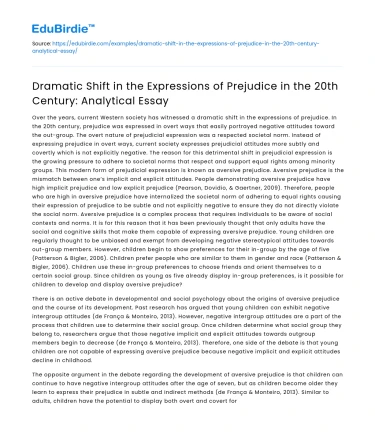Over the years, current Western society has witnessed a dramatic shift in the expressions of prejudice. In the 20th century, prejudice was expressed in overt ways that easily portrayed negative attitudes toward the out-group. The overt nature of prejudicial expression was a respected societal norm. Instead of expressing prejudice in overt ways, current society expresses prejudicial attitudes more subtly and covertly which is not explicitly negative. The reason for this detrimental shift in prejudicial expression is the growing pressure to adhere to societal norms that respect and support equal rights among minority groups. This modern form of prejudicial expression is known as aversive prejudice. Aversive prejudice is the mismatch between one’s implicit and explicit attitudes. People demonstrating aversive prejudice have high implicit prejudice and low explicit prejudice (Pearson, Dovidio, & Gaertner, 2009). Therefore, people who are high in aversive prejudice have internalized the societal norm of adhering to equal rights causing their expression of prejudice to be subtle and not explicitly negative to ensure they do not directly violate the social norm. Aversive prejudice is a complex process that requires individuals to be aware of social contexts and norms. It is for this reason that it has been previously thought that only adults have the social and cognitive skills that make them capable of expressing aversive prejudice. Young children are regularly thought to be unbiased and exempt from developing negative stereotypical attitudes towards out-group members. However, children begin to show preferences for their in-group by the age of five (Patterson & Bigler, 2006). Children prefer people who are similar to them in gender and race (Patterson & Bigler, 2006). Children use these in-group preferences to choose friends and orient themselves to a certain social group. Since children as young as five already display in-group preferences, is it possible for children to develop and display aversive prejudice?
There is an active debate in developmental and social psychology about the origins of aversive prejudice and the course of its development. Past research has argued that young children can exhibit negative intergroup attitudes (de França & Monteiro, 2013). However, negative intergroup attitudes are a part of the process that children use to determine their social group. Once children determine what social group they belong to, researchers argue that those negative implicit and explicit attitudes towards outgroup members begin to decrease (de França & Monteiro, 2013). Therefore, one side of the debate is that young children are not capable of expressing aversive prejudice because negative implicit and explicit attitudes decline in childhood.
Save your time!
We can take care of your essay
- Proper editing and formatting
- Free revision, title page, and bibliography
- Flexible prices and money-back guarantee
The opposite argument in the debate regarding the development of aversive prejudice is that children can continue to have negative intergroup attitudes after the age of seven, but as children become older they learn to express their prejudice in subtle and indirect methods (de França & Monteiro, 2013). Similar to adults, children have the potential to display both overt and covert forms of prejudice. This implies that children are not exempt from developing negative intergroup attitudes. Even young children have social and cognitive skills that make them capable of expressing aversive prejudice.
Although children are not believed to obtain the social and cognitive skills required to form prejudiced attitudes, children can use categorization. Children use categorization daily in the non-social and social world. Children use categorization to make sense of their environment. Consider children’s preferences for flowers over insects. For children to prefer flowers, they must be able to separate the two entities into different categories. The categorization of the non-social world is observed very clearly by the age of six (Baron & Banaji, 2006).
Did you like this example?
Make sure you submit a unique essay
Our writers will provide you with an essay sample written from scratch: any topic, any deadline, any instructions.
Cite this paper
-
APA
-
MLA
-
Harvard
-
Vancouver
20th Century Prejudice Expressions.
(2022, August 12). Edubirdie. Retrieved March 2, 2025, from https://edubirdie.com/examples/dramatic-shift-in-the-expressions-of-prejudice-in-the-20th-century-analytical-essay/
“20th Century Prejudice Expressions.” Edubirdie, 12 Aug. 2022, edubirdie.com/examples/dramatic-shift-in-the-expressions-of-prejudice-in-the-20th-century-analytical-essay/
20th Century Prejudice Expressions. [online].
Available at: <https://edubirdie.com/examples/dramatic-shift-in-the-expressions-of-prejudice-in-the-20th-century-analytical-essay/> [Accessed 2 Mar. 2025].
20th Century Prejudice Expressions [Internet]. Edubirdie.
2022 Aug 12 [cited 2025 Mar 2].
Available from: https://edubirdie.com/examples/dramatic-shift-in-the-expressions-of-prejudice-in-the-20th-century-analytical-essay/
copy






 Stuck on your essay?
Stuck on your essay?

